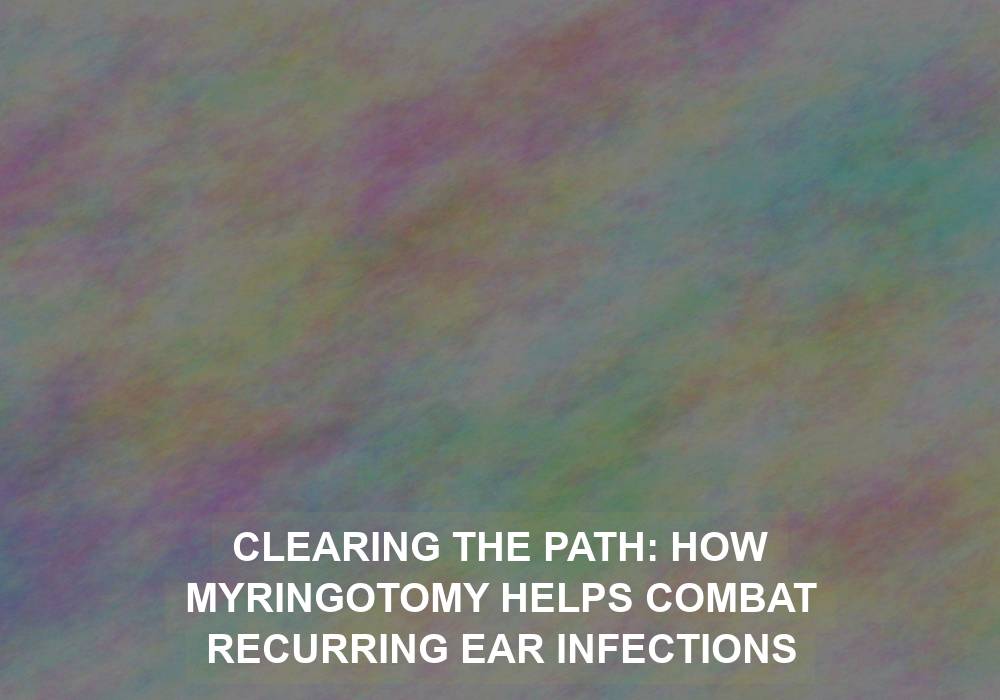Ear infections can be a recurring and extremely painful condition, especially for children. These infections not only cause discomfort but can also lead to hearing loss and more serious complications if left untreated. Fortunately, medical advancements have provided us with effective treatments to combat these recurring infections. One such treatment is known as myringotomy. In this article, we will explore what myringotomy is, how it works, and why it is an essential tool in the fight against recurring ear infections.
Understanding Myringotomy
Myringotomy, also known as tympanostomy tube insertion, is a surgical procedure that involves creating a small incision in the eardrum to relieve pressure and fluid buildup in the middle ear. This procedure is typically performed by an ear, nose, and throat (ENT) specialist and is usually done under general anesthesia.
During myringotomy, a tiny tube, called a tympanostomy tube, is inserted into the incision to keep it open and allow proper drainage. This tube helps to ventilate the middle ear and prevent the accumulation of fluid, which is often the underlying cause of recurring ear infections.
How Myringotomy Works
The primary goal of myringotomy is to improve the ventilation and drainage of the middle ear. By creating a small opening in the eardrum and inserting a tympanostomy tube, fluid buildup behind the eardrum can be easily drained. This helps to alleviate symptoms associated with recurring ear infections and prevents the formation of bacteria-friendly environments within the middle ear.
The tympanostomy tube acts as a passageway for fluid to flow out of the middle ear, reducing the risk of infection and allowing the ear to heal properly. This tube remains in place for a certain period of time, allowing the ear to recover and preventing the recurrence of infections.
Benefits of Myringotomy
1. Reduced Frequency of Infections
One of the major benefits of myringotomy is its role in reducing the frequency of ear infections. By alleviating fluid buildup and allowing proper drainage, the risk of recurrent infections is significantly decreased. This can lead to fewer doctor visits, fewer antibiotic prescriptions, and an overall improvement in the quality of life for the patient.
2. Improved Hearing
Recurring ear infections can cause temporary or permanent hearing loss due to the accumulation of fluid in the middle ear. By addressing the underlying cause of these infections, myringotomy helps restore normal hearing function, allowing individuals to communicate and interact without any hindrance.
The insertion of a tympanostomy tube not only allows fluid to drain but also equalizes the pressure in the middle ear. This helps improve the transmission of sound vibrations, resulting in improved hearing ability.
3. Prevention of Complications
If left untreated, recurring ear infections can lead to various complications. These may include the formation of a cholesteatoma (a skin growth behind the eardrum), eardrum perforation, or even the spread of infection to nearby structures such as the mastoid bone. Myringotomy helps prevent such complications by addressing the root cause of the infections promptly.
By creating a pathway for fluid drainage and relieving pressure in the middle ear, myringotomy reduces the risk of complications and ensures the overall health and well-being of the patient.
Who Can Benefit from Myringotomy?
Myringotomy is commonly recommended for individuals who experience recurrent ear infections, particularly those with chronic otitis media. This condition is characterized by persistent inflammation of the middle ear and recurrent episodes of fluid accumulation. Myringotomy is also beneficial for individuals who have experienced significant hearing loss due to recurrent infections.
Children, in particular, can benefit greatly from myringotomy as they are more prone to recurring ear infections. By addressing the underlying issue and providing a solution for proper drainage, myringotomy can significantly improve their quality of life and prevent long-term complications.
The Myringotomy Procedure
1. Preoperative Evaluation
Before undergoing myringotomy, a thorough evaluation is necessary to assess the individual’s medical history, current symptoms, and overall health. Diagnostic tests, including a physical examination, tympanometry, and audiogram, may be conducted to evaluate the severity of the condition and determine the appropriate course of treatment.
2. Surgical Procedure
During the actual myringotomy procedure, the patient is placed under general anesthesia to ensure their comfort and safety. The ENT specialist makes a small incision in the eardrum using a microscope and a specialized instrument. This incision allows the accumulated fluid to drain, and a tympanostomy tube is inserted into the opening. The procedure typically takes less than 30 minutes, and patients can usually return home on the same day.
3. Postoperative Care
After myringotomy, it is essential to follow specific postoperative care instructions provided by the ENT specialist. These instructions may include keeping the ear dry, avoiding activities that may introduce bacteria into the ear, and periodic follow-up appointments to monitor the healing process. The tympanostomy tubes are designed to eventually fall out on their own, but in some cases, they may need to be removed by the ENT specialist.
Conclusion
Myringotomy is a highly effective procedure for combating recurring ear infections. By relieving pressure, improving drainage, and preventing complications, it offers significant benefits to individuals suffering from chronic otitis media. If you or your child experiences frequent ear infections, it is essential to consult with an ENT specialist to determine whether myringotomy is a suitable treatment option. Remember, early intervention can help clear the path to a healthier and infection-free life.
